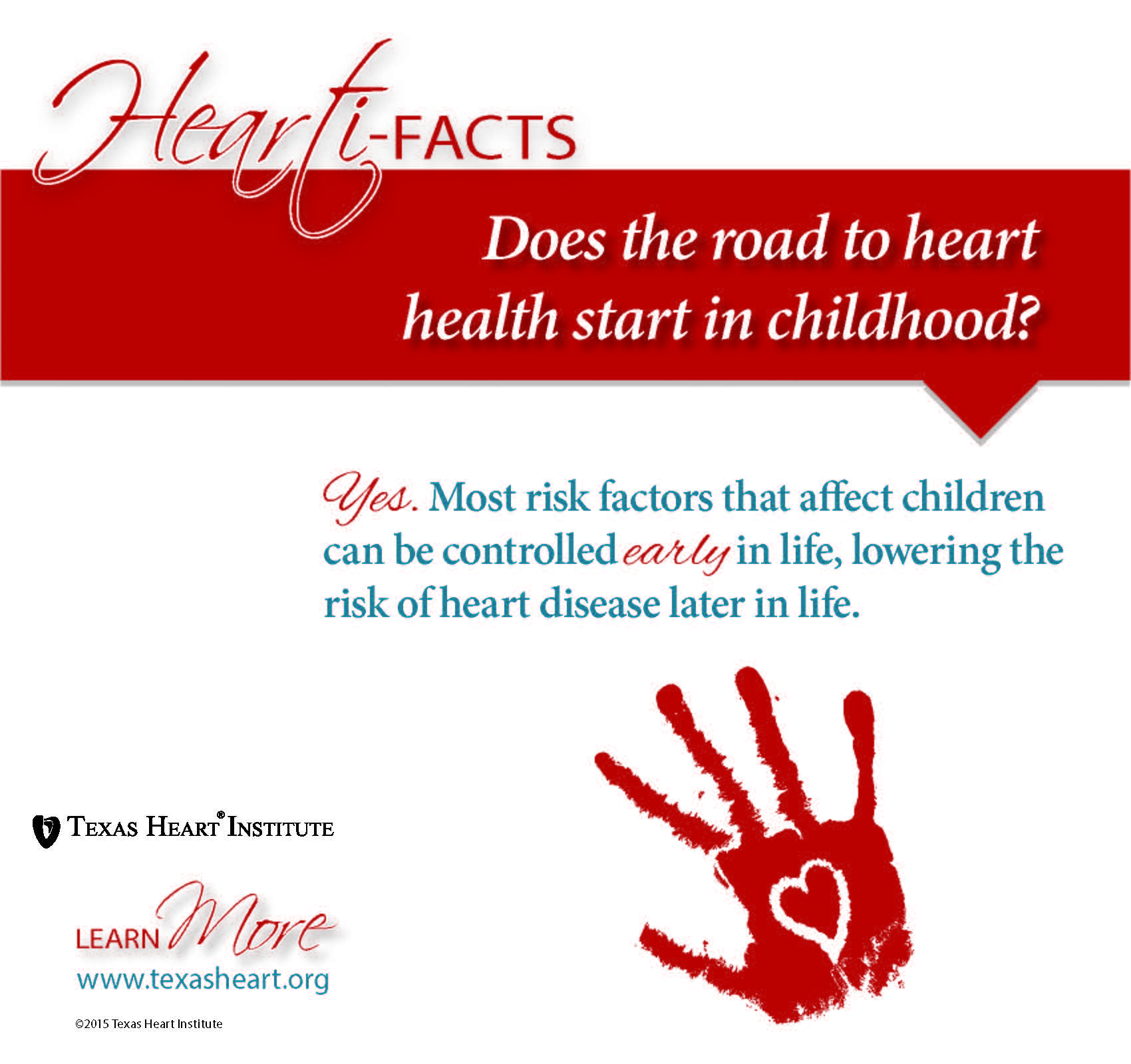
Heart disease is not a major cause of death among children and teenagers, but it is the largest cause of death among adults in the United States. In fact, someone in America dies every 37 seconds from some form of cardiovascular disease.
Certain factors play important roles in a person's chances of developing heart disease. These are called risk factors. Some risk factors can be changed, treated, or modified, and some cannot.
Many risk factors can be controlled early in life, lowering the risk of heart disease later in life. Other risk factors are passed down through family members (they are hereditary) or are the result of another illness or disease.
Prevention
is the best way to avoid a heart problem later in life. Controlling as many of
the following risk factors as possible,
starting in childhood, will help reduce your child's risk of developing heart
disease as an adult.
High Blood Pressure
Fewer than 3% of children in the United States have high blood pressure. But high blood pressure is a serious condition in childhood and often goes undetected because it causes no symptoms. Make sure that your child's blood pressure is checked at his or her yearly check-up.
What causes high blood pressure in children?
High blood pressure (hypertension) in children is not a congenital heart disease, but it can have a hereditary link. For that reason, children born into families with a history of high blood pressure need to have their blood pressure watched with special care.
Most cases of high blood pressure in children are the result of another disease, like heart or kidney disease. This is called secondary hypertension.
How is blood pressure measured?
The doctor will measure your child's blood pressure using a device called a sphygmomanometer.
Blood pressure readings measure the two parts of blood pressure: systolic and diastolic pressures. Systolic pressure is the force of blood flow through an artery when the heart beats. Diastolic pressure is the force of blood flow within blood vessels when the heart rests between beats.
The doctor will look at your child's age, sex, and height to determine the specific systolic and diastolic blood pressures. Doctors use this method because it lets them look at different levels of growth to determine blood pressure. It also lets them get the most accurate classification of blood pressure according to your child's body size.
How is high blood pressure in children treated?
In most cases, lifestyle changes will help children control their high blood pressure.
- Help your child maintain a healthy body weight. Children who are overweight usually have higher blood pressure than those who are not.
- Increase their physical activity.
- Limit how much salt they eat.
- Warn them about the dangers of cigarette smoking. The nicotine in cigarettes causes the blood vessels to narrow, making it even harder for blood to flow through the vessels.
If a program of diet and exercise does not lower your child's blood pressure, medicines may be prescribed.
See also on this site: High Blood Pressure
Cholesterol
Less than 15% of children have high cholesterol levels, but studies have shown that fatty plaque buildup begins in childhood and progresses into adulthood. This disease process is called atherosclerosis. In time, atherosclerosis leads to heart disease, which is the single biggest cause of death in the United States.
|
Guidelines for Cholesterol Testing in Children and Young Adults
Studies have shown an association between cholesterol disorders and the onset of atherosclerosis in children, adolescents, and young adults. And, just like adults, eating foods high in saturated fat, not getting enough exercise, and having a family history of heart disease can all lead to high cholesterol levels in children. An increase in childhood obesity is also leading to high cholesterol levels at earlier ages. As a result, guidelines endorsed by the American Academy of Pediatrics state that all children, even if they do not have a family history of heart disease, should have their cholesterol levels tested between the ages of 9 and 11, and then again between the ages of 17 and 21. Doctors think that this early testing and control of cholesterol levels in childhood can help reduce the risk of heart disease in adulthood.
|
What is cholesterol?
Cholesterol is a fat-like substance called a lipid that is found in all body cells. The liver makes all of the cholesterol your body needs to form cell membranes and to make certain hormones. Extra cholesterol enters the body when you eat foods that come from animals, like meats, eggs, and dairy products and from foods high in saturated fats.
Cholesterol travels to cells through the bloodstream in special carriers called lipoproteins. Two of the most important lipoproteins are low-density lipoprotein (LDL) and high-density lipoprotein (HDL). Doctors look at how LDL, HDL, and fats called triglycerides relate to each other and to your total cholesterol level.
What causes high cholesterol in children and teenagers?
In some cases, high cholesterol runs in families. This is called familial hypercholesterolemia. About 1% to 2% of children have this condition, and they should have their cholesterol levels checked before they are 5 years old.
Other risk factors for high cholesterol include obesity, high blood pressure, and smoking.
|

|
Find resources to help make nutrition fun for kids. |
How is high cholesterol prevented or treated?
To reduce the risk of fatty buildup in the arteries, your child should
- Get plenty of exercise. Encourage them to exercise 30 to 60 minutes on most days of the week.
- Eat foods low in cholesterol and fat. Have your child eat more whole grains and fresh fruits and vegetables. (Note: You should not restrict how much fat children eat if they are younger than two years old. Infants need fat for growth and development. After the age of two, children should start to eat fewer calories from fat.)
- Know the dangers of cigarette smoking.
- Learn to control weight to avoid the risks associated with obesity.
- Control their diabetes, high blood pressure, or other conditions that contribute to heart disease.
Children who have been diagnosed with high cholesterol will need to at least follow a special program of diet and exercise. If 1 year of diet and exercise therapy does not lower their cholesterol, statins or other cholesterol-lowering medicines may be prescribed.
See also on this site: Cholesterol
Smoking
According to the Centers for Disease Control (CDC), nearly 25% of high school students use some kind of tobacco product, and nearly 4,000 kids under age 18 try their first cigarette every day. In fact, 9 out of 10 smokers had started smoking before they finished high school. This means that if children can stay smoke-free in school, they will probably never smoke.
More than 90,000 people die each year from heart diseases caused by smoking. Among young people who would otherwise have a very low risk of heart disease, cigarette smoking may cause as many as 75 percent of the cases of heart disease. And, the longer a person smokes, the higher the risk of heart disease.
How does smoking affect the heart?
Better known for increasing your risk of lung cancer, cigarette and tobacco smoking also increase the risk of heart disease and peripheral vascular disease (disease in the vessels that supply blood to the arms and legs).
According to the Surgeon General, most teens who smoke are addicted to the nicotine in cigarettes. Nicotine narrows the blood vessels and puts an added strain on the heart. Even when teens want to quit smoking, the nicotine addiction makes it very hard, and they go through the same withdrawal symptoms that adults do.
Although nicotine is the main active agent in cigarette smoke, other chemicals and compounds like tar and carbon monoxide are also harmful to the heart. Research has shown that smoking increases heart rate, tightens major arteries, and can create irregularities in the timing of heartbeats, all of which make the heart work harder. Chemicals in cigarette and tobacco smoke lead to the buildup of fatty plaque in the arteries, possibly by injuring the vessel walls. These chemicals also affect cholesterol and levels of fibrinogen, which is a blood-clotting material. This increases the risk of a blood clot that can lead to a heart attack.
How can I discourage my child from smoking?
- Talk to them about the bad effects of smoking, such as yellow teeth, bad breath, smelly clothes, and shortness of breath. If your child likes to play sports, tell him or her how smoking can damage the lungs and reduce the supply of oxygen that the muscles need to work properly.
- Talk openly with your child about the dangers of smoking.
- Compliment teens who do not smoke. In a survey by the CDC, results showed that more young people do not smoke than do. The majority of teens polled said that they thought smoking was unattractive and that they would not date someone who smokes.
- Be a role model for your child. If you smoke, quit. And do not allow others to smoke in your home.
How can I help my child quit smoking?
- Advise them on how to quit, but be helpful and supportive.
- Help them figure out the reasons why they should quit, such as living longer; lowering their chances of heart attack, stroke, or cancer; and having more money to spend on things other than cigarettes.
- If you smoke, agree to quit with them. About half of all teen smokers have parents who smoke.
- Have your child see a doctor for advice on how to quit.
Smoking is the single most preventable cause of death. If smoking rates among teens do not decrease, 5.6 million Americans will die later in life of diseases caused by smoking.
See also on this site: Smoking and Your Heart
Obesity
Obesity is a major risk factor for heart disease. This is alarming when you consider that 1 out of every 3 American adults is obese. Recent studies have shown that obesity is linked to more than 110,000 deaths in the United States each year.
Childhood obesity in the United States has become a problem in recent years. According to the American Academy of Child and Adolescent Psychiatry, between 16% and 33% of children and teenagers are obese. As a result, there has been a sharp rise in obesity-related problems like type 2 diabetes, which is usually seen only in adults. Because obese children are more likely to be obese adults, preventing or treating obesity in childhood may reduce the risk of adult obesity. In turn, this may help reduce the risk of heart disease, diabetes, and other obesity-related diseases.
What is obesity and what causes it?
Our bodies are made up of water, fat, protein, carbohydrates, vitamins, and minerals. Obesity means that you have too much body fat.
For some people, the cause of obesity is quite simple: they are eating more calories than they are burning during exercise and daily life. Other causes of obesity may include genetics, aging, gender, lifestyle, and illness.
Obesity in children is dangerous because researchers believe that the fat cells we gain as children stay with us as adults. Obese children may have 5 times more fat cells than children of normal weight. Dieting in adulthood will decrease the fat-cell size but not the actual number of fat cells.
How do I know if my child is obese?
When determining body fat in children and teens, body mass index (BMI) provides a guideline based on weight and height to determine underweight and overweight. Assessing BMI depends on the child's age because as children grow, the amount of body fat they have changes. Also, girls and boys will have different amounts of body fat as they grow, so age-specific and sex-specific charts are used to plot children's BMI.
BMI is a formula of weight in kilograms divided by height in meters squared (BMI =kg/m2). To find your child's BMI, use the calculator below.



